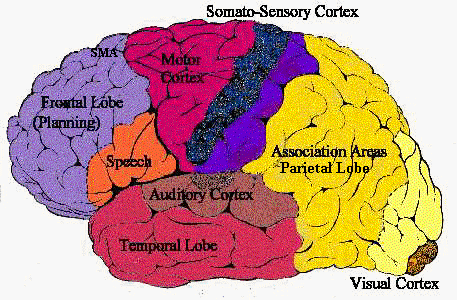Neuroanatomy
 There
is no single neural locus for learning, rather a multiplicity of brain
structures are involved in motor control. This page reviews five main brain
structures and their role in motor control as well as other structures
involved in motor learning.
There
is no single neural locus for learning, rather a multiplicity of brain
structures are involved in motor control. This page reviews five main brain
structures and their role in motor control as well as other structures
involved in motor learning.
Main
Structures Involved in Motor Control
1. Motor tracts are
responsible for transferring information from the brain to the muscles.
Muscle contraction is caused by an impulse from from a neuron at the neuromuscular
junction. Hence for muscles to move information must be relayed from
the nervous system to the muscles. Four pathways are involved in
this: (a) the corticospinal, (b) corticobulbar, (c) ventromedial and (d)
rubrospinal pathways.
 A.
Corticospinal Tract
A.
Corticospinal Tract
Links the cortex to
the spinal cord
Lateral tract controls
distal limbs
Ventral tract controls
the muscles of trunk and upper leg
B. Corticobulbar Tract
Connects motor cortex
to cranial nerves in the pons
Important in tongue
and face innervation
C. Ventromedial Tract
Links brainstem to the
spinal cord, with indirect linkages to the primary motor cortex
Primary function is
to control movements of the trunk and proximal limb muscles, especially
in posture
Important for coordinating
eye movements with those of the head and trunk.
D. Rubrospinal Pathway
Originates in the midbrain
and has connections with the motor cortex, cerebellum and spinal cord.
Modulates motor movements
2. The cerebellum
plays an important role in the modulation of motor movements and in the learning of motor skills. It is thought to improve
the coordination of muscles and to maintain equilibrium. The cerebellum
also contributes to generating and planning movements.
movements and in the learning of motor skills. It is thought to improve
the coordination of muscles and to maintain equilibrium. The cerebellum
also contributes to generating and planning movements.
3. The basal ganglia
consist of three nuclei, the caudate nucleus, putamen and globus pallidus. The putamen and caudate receive input
from all regions of the cerebral cortex and the substantia nigra.
The globus pallidus send information to the thalamus. The basal ganglia
have multiple roles in motor control including:
putamen and globus pallidus. The putamen and caudate receive input
from all regions of the cerebral cortex and the substantia nigra.
The globus pallidus send information to the thalamus. The basal ganglia
have multiple roles in motor control including:
"Setting" the motor
system with regard to posture
Preparation for voluntary
movements
Act as an autopilot for
well-learned behaviors.
Involved in motor planning
and learning
Plays a role in cognitive
components of learning
Facilitates ongoing action
Suppresses unwanted movement
4. Several areas
of the frontal lobe are involved in the planning and execution of movements
including the motor cortex, supplementary motor cortex, and the
anterior cingulate cortex.

A. Primary Motor Cortex
Relays information to
the spinal cord to enable muscle control
Receives input from
several areas of the cortex
B. Supplementray Motor
Area (SMA)
Activated during tasks
requiring complicated motor sequencing
Commands are thought
to be programmed in the SMA
Specifically involved
in complex tasks
C. Anterior Cingulate
Cortex
Implicated for control
and planning of movements
May play a role in linking
motor and cognitive behavior
Most active when novel
responses are required
5. The parietal lobes
(association cortex) is involved in the control of movements in space and
contributes to the ability to produce complex, well-learned motor acts.
Parietal regions integrate sensory information to allow for correct spatial
positioning of limbs in space. Parietal regions also receive feedback
from motor and pre-motor areas which is used to ensure that movements are
being executes as planned.
Other
Important Structures
Several
other structures are necessary for a motor skill to be carried out.
The thalamus is important for organizing and directing incoming
information to other regions of the brain. It also modifies information
descending from the cortex.
The spinal
cord is the information highway relaying information to and from the
brain. It has several ascending and descending pathways. It
also contains motor programs for a number of common behaviors (i.e. walking)
and reflex pathways. The cerebral cortex turns on the appropriate
motor program in the spinal cord.
Back to Neural Factors
& Motor Learning Stages
of Learning
Skill Execution
Paraplegic
Considerations
 There
is no single neural locus for learning, rather a multiplicity of brain
structures are involved in motor control. This page reviews five main brain
structures and their role in motor control as well as other structures
involved in motor learning.
There
is no single neural locus for learning, rather a multiplicity of brain
structures are involved in motor control. This page reviews five main brain
structures and their role in motor control as well as other structures
involved in motor learning.
 movements and in the learning of motor skills. It is thought to improve
the coordination of muscles and to maintain equilibrium. The cerebellum
also contributes to generating and planning movements.
movements and in the learning of motor skills. It is thought to improve
the coordination of muscles and to maintain equilibrium. The cerebellum
also contributes to generating and planning movements. putamen and globus pallidus. The putamen and caudate receive input
from all regions of the cerebral cortex and the substantia nigra.
The globus pallidus send information to the thalamus. The basal ganglia
have multiple roles in motor control including:
putamen and globus pallidus. The putamen and caudate receive input
from all regions of the cerebral cortex and the substantia nigra.
The globus pallidus send information to the thalamus. The basal ganglia
have multiple roles in motor control including: